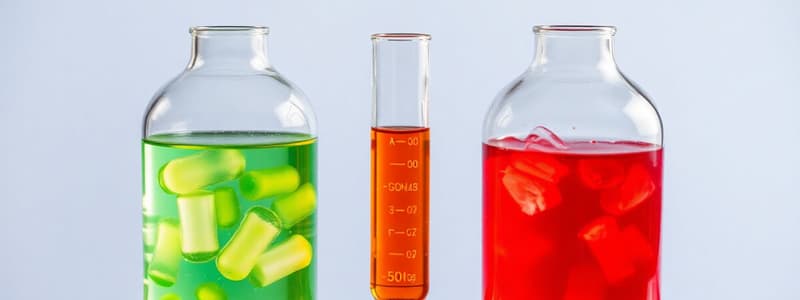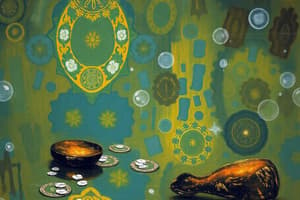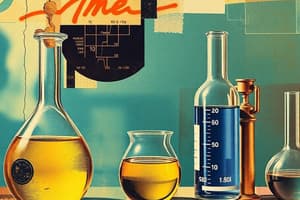Podcast
Questions and Answers
Generally, what taste do acids have?
Generally, what taste do acids have?
Sour
Early chemists easily determined the reasons for acids having a set of common properties.
Early chemists easily determined the reasons for acids having a set of common properties.
False (B)
Who is the French chemist credited with describing acids as substances that contain oxygen?
Who is the French chemist credited with describing acids as substances that contain oxygen?
Antoine Lavoisier
Which of the following acids do NOT fit Lavoisier's definition of acids as substances that contain oxygen?
Which of the following acids do NOT fit Lavoisier's definition of acids as substances that contain oxygen?
Who proposed the theory that acids are hydrogen compounds where hydrogen can be replaced by metals?
Who proposed the theory that acids are hydrogen compounds where hydrogen can be replaced by metals?
What are the two key characteristics that define acids, according to the standard definition?
What are the two key characteristics that define acids, according to the standard definition?
The standard definition of acids explains their chemical structure.
The standard definition of acids explains their chemical structure.
Acids release hydrogen ions in solutions.
Acids release hydrogen ions in solutions.
When hydrogen chloride dissolves in water, what ions are formed?
When hydrogen chloride dissolves in water, what ions are formed?
What is the active ingredient in an acidic solution, rather than a simple hydrogen ion?
What is the active ingredient in an acidic solution, rather than a simple hydrogen ion?
The oxonium ion is also known as the ______ ion.
The oxonium ion is also known as the ______ ion.
Which of the following reactions accurately represents the dissociation of nitric acid (HNO3) in water?
Which of the following reactions accurately represents the dissociation of nitric acid (HNO3) in water?
Flashcards
Acid
Acid
A substance that produces hydrogen ions (H+) when dissolved in water. They have a sour taste and react with metals.
Base
Base
A substance that accepts protons (H+) in a chemical reaction. They can neutralize acids.
Salt
Salt
A chemical compound formed by the reaction of an acid with a base. They are usually composed of a cation and an anion.
Redox reaction
Redox reaction
Signup and view all the flashcards
Oxidation
Oxidation
Signup and view all the flashcards
Reduction
Reduction
Signup and view all the flashcards
Oxidizing agent
Oxidizing agent
Signup and view all the flashcards
Reducing agent
Reducing agent
Signup and view all the flashcards
Strong acid
Strong acid
Signup and view all the flashcards
Weak acid
Weak acid
Signup and view all the flashcards
Concentrated acid
Concentrated acid
Signup and view all the flashcards
Dilute acid
Dilute acid
Signup and view all the flashcards
pH
pH
Signup and view all the flashcards
Brønsted-Lowry acid
Brønsted-Lowry acid
Signup and view all the flashcards
Brønsted-Lowry base
Brønsted-Lowry base
Signup and view all the flashcards
Lewis acid
Lewis acid
Signup and view all the flashcards
Lewis base
Lewis base
Signup and view all the flashcards
Neutralization reaction
Neutralization reaction
Signup and view all the flashcards
Coordinate covalent bond
Coordinate covalent bond
Signup and view all the flashcards
Intermolecular forces
Intermolecular forces
Signup and view all the flashcards
Gas
Gas
Signup and view all the flashcards
Pressure
Pressure
Signup and view all the flashcards
Temperature
Temperature
Signup and view all the flashcards
Volume
Volume
Signup and view all the flashcards
Liquid
Liquid
Signup and view all the flashcards
Solid
Solid
Signup and view all the flashcards
Vaporization
Vaporization
Signup and view all the flashcards
Condensation
Condensation
Signup and view all the flashcards
Study Notes
Acids, Bases and Salts
- Acids generally taste sour and react strongly with metals.
- Bases react with acids.
- Early chemists struggled to define why acids shared common properties.
- Antoine Lavoisier suggested acids contain oxygen, but this wasn't universally applicable.
- Justus von Liebig later proposed that acids contain hydrogen that can be replaced by metals.
- The standard definition of an acid is that it releases hydrogen ions (H+) in solution.
Redox Reactions
- A redox reaction involves both oxidation and reduction.
- Oxidation is the loss of electrons, while reduction is the gain of electrons.
- The number of electrons lost in oxidation equals the number gained in reduction.
- In the reaction: Cu²+(aq) + Zn(s) → Zn²+(aq) + Cu(s), copper ions gain electrons to form copper metal (reduction), and zinc metal loses electrons to form zinc ions (oxidation).
- Oxidizing agents cause oxidation in a reaction and are reduced; meanwhile, reducing agents cause reduction and are oxidized.
- In the example: Cu²+(aq) + Zn(s) → Zn²+(aq) + Cu(s), Cu²+(aq) is the oxidizing agent and Zn(s) the reducing agent.
Balancing Redox Reactions
- Balancing redox reactions involves balancing the number of atoms and electrons in the reaction.
- In an acidic medium, water (H₂O) and hydrogen ions (H⁺) are used to balance oxygen and hydrogen atoms respectively.
- In a basic medium, water (H₂O) and hydroxide ions (OH⁻) are used.
Salts
- Salts are composed of small ions, typically hard and brittle with high melting and boiling points.
- They are ionic compounds containing at least two elements.
- The formation of salts is typically formed by an acid and a base.
- Ions carry a charge due to loss or gain of valence electrons.
- Positively charged ions are called cations, negatively charged ions are called anions
- Salts are generally highly soluble in water due to their polarity; consequently, water molecules pull apart the cations and anions breaking their ionic bonds.
- Salts have crystalline structures and can appear in various colours.
- Examples include calcium chloride and copper sulfate.
Studying That Suits You
Use AI to generate personalized quizzes and flashcards to suit your learning preferences.




